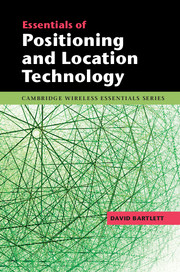Book contents
- Frontmatter
- Contents
- Miscellaneous Frontmatter
- 1 Introduction
- 2 Coordinate systems
- 3 Satellite positioning (GNSS)
- 4 Radiolocation technologies
- 5 Inertial navigation
- 6 Other techniques and hybrid systems
- 7 Techniques and performance
- 8 When things go wrong
- 9 Location-based services and applications
- 10 A brief look at the future
- References
- Index
8 - When things go wrong
Published online by Cambridge University Press: 05 April 2013
- Frontmatter
- Contents
- Miscellaneous Frontmatter
- 1 Introduction
- 2 Coordinate systems
- 3 Satellite positioning (GNSS)
- 4 Radiolocation technologies
- 5 Inertial navigation
- 6 Other techniques and hybrid systems
- 7 Techniques and performance
- 8 When things go wrong
- 9 Location-based services and applications
- 10 A brief look at the future
- References
- Index
Summary
Localisation and positioning are probabilistic
Any system for determining position or location is probabilistic in that the position it computes is based on noisy measurements and uncertainty. There is no such thing as absolute certainty or guarantee of the output. Therefore any application utilising the output of the system should take this probabilistic nature into account. All too often applications have not done this adequately leading to a level of scepticism amongst users, and in some cases mistrust of the systems.
Locating objects requires a system
In most ‘professional’ uses of locating systems it is necessary to place a level of trust in the system and to have confidence that it is correct. For these applications it is often useful to quantify the required system performance:
What is meant by a location or position? Is it occupancy of a ‘zone’ such as presence in a room, a parking bay or a particular stretch of road? Is the position static or described by a sequence of positions (trajectory)?
What is the duration of the location ‘event’? What defines the start and end times of the event? How long do we have (realistically) to generate a location output?
What is the acceptable level of false positive reports? A false positive is when the system reports that an object is in a particular location (for example room or parking bay) but it isn’t.
What is a tolerable level of failed location reports? This is when the system is unable (or unwilling) to output an object’s location. This is generally a less severe error condition in which the user is told that the system does not know where the object is and has to resort to backup or alternative methods for obtaining the position.
- Type
- Chapter
- Information
- Essentials of Positioning and Location Technology , pp. 143 - 162Publisher: Cambridge University PressPrint publication year: 2013

